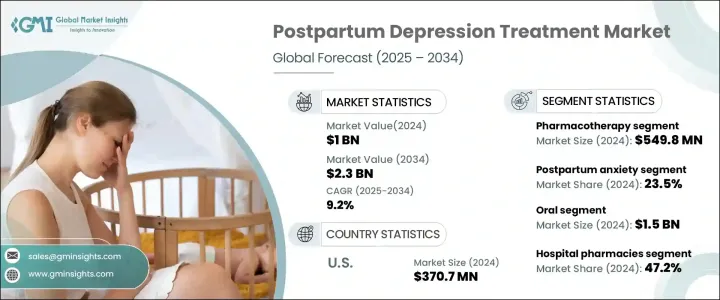PUBLISHER: Global Market Insights Inc. | PRODUCT CODE: 1684675

PUBLISHER: Global Market Insights Inc. | PRODUCT CODE: 1684675
Postpartum Depression Treatment Market Opportunity, Growth Drivers, Industry Trend Analysis, and Forecast 2025 - 2034
The Global Postpartum Depression Treatment Market reached USD 1 billion in 2024 and is anticipated to expand at a robust CAGR of 9.2% between 2025 and 2034. This rapid growth reflects increasing awareness of maternal mental health and the critical need for effective interventions. Postpartum depression, affecting a significant percentage of new mothers globally, has been thrust into the spotlight as a public health concern.

As mental health becomes a central component of maternal care, healthcare systems worldwide are evolving to prioritize comprehensive postpartum support. The rise in demand for innovative treatments, alongside the growing focus on early diagnosis, has created fertile ground for advancements in this market. Governments, healthcare organizations, and advocacy groups are working in tandem to destigmatize postpartum depression, enabling more women to seek help. These collective efforts are fostering a market environment that encourages innovation, research, and investment in groundbreaking therapies.
| Market Scope | |
|---|---|
| Start Year | 2024 |
| Forecast Year | 2025-2034 |
| Start Value | $1 Billion |
| Forecast Value | $2.3 Billion |
| CAGR | 9.2% |
In recent years, a paradigm shift in how postpartum depression is perceived has contributed to this market's rapid development. Routine screening during postnatal care has become standard practice in many regions, allowing healthcare providers to identify and address postpartum depression early. Public health campaigns are shedding light on the importance of maternal mental well-being, making it easier for women to recognize symptoms and seek treatment. Improved healthcare infrastructure, coupled with advancements in telemedicine and digital health solutions, has increased access to care, especially for underserved populations. These developments have laid the foundation for sustained market growth as the demand for targeted treatments continues to rise.
The postpartum depression treatment market is segmented based on associated conditions, including postpartum anxiety, postpartum blues, postpartum post-traumatic stress disorder (PTSD), postpartum obsessive-compulsive disorder (OCD), postpartum panic disorder, and postpartum psychosis. Among these, postpartum anxiety accounted for the largest share at 23.5% in 2024. This condition is highly prevalent among new mothers, driving demand for effective treatment options. The emphasis on maternal mental health, coupled with enhanced access to healthcare services, has improved diagnosis rates and treatment adoption. The growing popularity of telehealth platforms has further bolstered access to care, ensuring timely interventions for individuals in need.
In the United States, the postpartum depression treatment market was valued at USD 370.7 million in 2024, with projections indicating an 8.9% CAGR through 2032. Several factors fuel this growth, including the increasing prevalence of postpartum depression, greater public awareness of maternal mental health, and the availability of cutting-edge therapies. The U.S. healthcare system, with its established infrastructure and supportive mental health policies, plays a pivotal role in enhancing accessibility. Insurance coverage for postpartum depression treatments has further encouraged adoption, driving continued market expansion across the country.
Table of Contents
Chapter 1 Methodology and Scope
- 1.1 Market scope and definition
- 1.2 Research design
- 1.2.1 Research approach
- 1.2.2 Data collection methods
- 1.3 Base estimates and calculations
- 1.3.1 Base year calculation
- 1.3.2 Key trends for market estimation
- 1.4 Forecast model
- 1.5 Primary research and validation
- 1.5.1 Primary sources
- 1.5.2 Data mining sources
Chapter 2 Executive Summary
- 2.1 Industry 360° synopsis
Chapter 3 Industry Insights
- 3.1 Industry ecosystem analysis
- 3.2 Industry impact forces
- 3.2.1 Growth drivers
- 3.2.1.1 Increasing prevalence of postpartum depression
- 3.2.1.2 Advancements in drug development
- 3.2.1.3 Growing awareness and focus on women's health
- 3.2.2 Industry pitfalls and challenges
- 3.2.2.1 Safety concerns due to associated side effects
- 3.2.2.2 High cost of postpartum depression drugs
- 3.2.1 Growth drivers
- 3.3 Growth potential analysis
- 3.4 Future trends
- 3.5 Regulatory landscape
- 3.6 Pipeline analysis
- 3.7 Porter's analysis
- 3.8 PESTEL analysis
Chapter 4 Competitive Landscape, 2024
- 4.1 Introduction
- 4.2 Company matrix analysis
- 4.3 Competitive analysis of major market players
- 4.4 Competitive positioning matrix
- 4.5 Strategy dashboard
Chapter 5 Market Estimates and Forecast, By Type, 2021 – 2034 ($ Mn)
- 5.1 Key trends
- 5.2 Postpartum anxiety
- 5.3 Postpartum blues
- 5.4 Postpartum post-traumatic stress disorder (PTSD)
- 5.5 Postpartum obsessive-compulsive disorder (OCD)
- 5.6 Postpartum panic disorder
- 5.7 Postpartum psychosis
Chapter 6 Market Estimates and Forecast, By Treatment, 2021 – 2034 ($ Mn)
- 6.1 Key trends
- 6.2 Pharmacotherapy
- 6.2.1 Selective serotonin reuptake inhibitors (SSRIs)
- 6.2.2 Serotonin norepinephrine reuptake inhibitors (SNRIs)
- 6.2.3 Tricyclic antidepressants (TCA)
- 6.2.4 Other pharmacotherapies
- 6.3 Hormone therapy
- 6.4 Other treatments
Chapter 7 Market Estimates and Forecast, By Route of Administration, 2021 – 2034 ($ Mn)
- 7.1 Key trends
- 7.2 Oral
- 7.3 Parenteral
- 7.4 Other routes of administration
Chapter 8 Market Estimates and Forecast, By Distribution Channel, 2021 – 2034 ($ Mn)
- 8.1 Key trends
- 8.2 Hospital pharmacies
- 8.3 Retail pharmacies
- 8.4 Online pharmacies
Chapter 9 Market Estimates and Forecast, By Region, 2021 – 2034 ($ Mn)
- 9.1 Key trends
- 9.2 North America
- 9.2.1 U.S.
- 9.2.2 Canada
- 9.3 Europe
- 9.3.1 Germany
- 9.3.2 UK
- 9.3.3 France
- 9.3.4 Italy
- 9.3.5 Spain
- 9.3.6 Netherlands
- 9.4 Asia Pacific
- 9.4.1 China
- 9.4.2 Japan
- 9.4.3 India
- 9.4.4 Australia
- 9.4.5 South Korea
- 9.5 Latin America
- 9.5.1 Brazil
- 9.5.2 Mexico
- 9.5.3 Argentina
- 9.6 Middle East and Africa
- 9.6.1 South Africa
- 9.6.2 Saudi Arabia
- 9.6.3 UAE
Chapter 10 Company Profiles
- 10.1 Bausch Health Companies
- 10.2 Biogen
- 10.3 Cipla
- 10.4 Eli Lilly and Company
- 10.5 GSK
- 10.6 Merck
- 10.7 Novartis
- 10.8 Pfizer
- 10.9 Sage Therapeutics
- 10.10 Teva Pharmaceutical Industries




